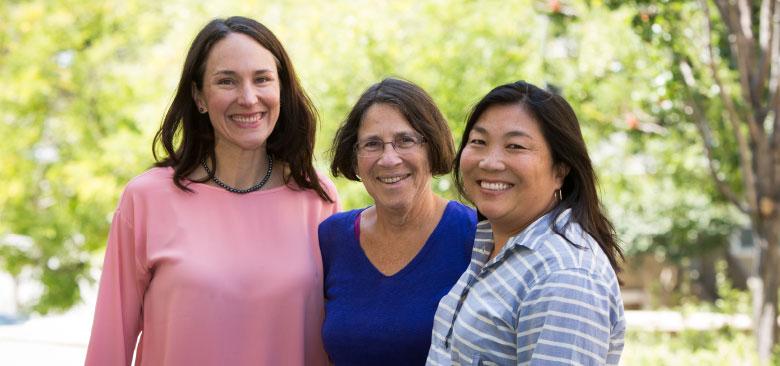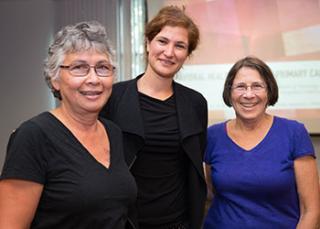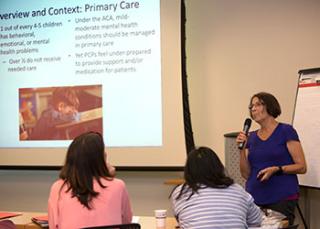
From left: Petra Steinbuchel, Naomi Schapiro, Shelly Nakaishi (photos by Elisabeth Fall)
School Health Centers Integrate Behavioral Health with Primary Care
As part of her pediatric nurse practitioner program at UC San Francisco School of Nursing, Bopha Sin-Berry (MS ’16) was doing a clinical rotation at a primary care clinic when a 14-year-old girl came in with her father. The teen feared she might be pregnant because she hadn’t been following the prescribed regimen for her oral contraceptives.
However, as Sin-Berry and her preceptor began taking a history, it became clear that while the patient might not be pregnant, something more serious was at stake: She was contemplating suicide.
Because it was precisely the type of situation Sin-Berry had been learning about in a behavioral health class, she pulled up the slides that described the protocols for treating suicidal ideation – and she and her preceptor put a treatment plan in place that day, which included a comprehensive safety plan and a referral to psychotherapy. And when the girl and her father returned to the clinic a week later, her mood was already on the upswing.
“My whole [RN] nursing career had been in inpatient pediatrics, so this was my first real interaction of this kind,” says Sin-Berry. “It made clear to me why integrated behavioral health is so important.”
The Growing Importance of Integrated Behavioral Health
Integrated behavioral health – broadly defined as medical (usually primary care) and behavioral health providers delivering some version of team-based care – is on the rise. It stems from increased recognition of the mind-body connection for a range of health conditions, as well as from a need to create more efficiency in care delivery.
That recognition has legislators and insurers working to spur the growth of integrated behavioral health. Provisions in the Affordable Care Act support its use. The U.S. Preventive Services Task Force recommends that every child aged 12 to 18 be screened for major depression. Many insurers, including Medi-Cal, are incentivizing providers to treat mild to moderate depression and anxiety in primary care.
“These forces drive everyone to build capacity to meet mental health needs in primary care settings,” says Shelly Nakaishi, who as volunteer clinical faculty at the School was one of the instructors in Sin-Berry’s class. Nakaishi is also a certified pediatric nurse practitioner and primary care mental health specialist. She has worked for the last decade in the Department of Psychiatry at UCSF Benioff Children’s Hospital Oakland and, in the last year, has helped to increase behavioral health integration in the hospital’s Federally Qualified Health Center (FQHC) sites.
 From left: Kimi Sakashita and Marta Lutsky from the Alameda County Center for Healthy Schools and Communities, and Naomi Schapiro The capacity building takes many forms. Primary care providers might undergo training in how to screen for and treat mild to moderate mental illness and recognize when referring to specialty mental health is appropriate. Both primary care and behavioral health providers experiment with team-based care models designed to better diagnose and treat mental and physical health concerns. And schools of nursing, medicine, pharmacy, psychology and social work are updating their curricula to reflect changing perceptions about how to most effectively deliver care.
From left: Kimi Sakashita and Marta Lutsky from the Alameda County Center for Healthy Schools and Communities, and Naomi Schapiro The capacity building takes many forms. Primary care providers might undergo training in how to screen for and treat mild to moderate mental illness and recognize when referring to specialty mental health is appropriate. Both primary care and behavioral health providers experiment with team-based care models designed to better diagnose and treat mental and physical health concerns. And schools of nursing, medicine, pharmacy, psychology and social work are updating their curricula to reflect changing perceptions about how to most effectively deliver care.
All of these changes help explain a recent Health Resources and Services Administration (HRSA) grant, which the School’s Naomi Schapiro secured, known as INPEC5, or Interprofessional Nurse Practitioner Education for the Collaborative Care of Children with Chronic Conditions. The ambitious grant brings interprofessional training to pediatric nurse practitioner (PNP) students and psychiatric/mental health NP (PMHNP) students from the School, behavioral health trainees at UCSF Benioff Children’s Hospital Oakland, social work students from California State University, East Bay, primary care providers associated with Alameda County’s 29 school health centers (SHCs), and a couple of local pediatric practices with a high percentage of Medi-Cal patients. Many of the trainings have been conducted in partnership with the Alameda County Center for Healthy Schools and Communities, which provides financial and technical assistance to the SHCs.
“The primary focus [of INPEC5] is on behavioral health and obesity as intertwined conditions, but we also look more broadly at the interaction between chronic conditions and mental or behavioral health,” says Schapiro.
Grant to Build Provider Confidence, Comfort with Integrated Behavioral Health
The idea for INPEC5 grew out of UCSF’s Elev8 Healthy Students and Families project, in which UCSF School of Nursing and School of Dentistry faculty and students enhanced and expanded services at health centers within five Oakland middle schools. As the Elev8 grant came to a close, Schapiro – who also serves as clinical faculty at a school health center run by La Clínica de La Raza at San Lorenzo High School – and her colleagues surveyed school-based primary care providers and found that many had concerns about managing mental health conditions and medications without additional training and consultative support.
Thus, the grant has many components, including online and in-person training for diverse providers, helping students bring primary care and behavioral health skills to group treatment of obesity, and implementation of a warm consultation line for providers. “The warm line might be the most innovative piece, with the professional answering the phone providing decision support to providers calling for help managing mild to moderate behavioral health conditions,” says Schapiro.
“These types of efforts recognize that there is not enough attention given to how much of primary care stems from mental health complaints,” says psychiatrist Petra Steinbuchel of UCSF Benioff Children’s Hospital Oakland. Steinbuchel, who is also a UCSF clinical faculty member, is working with Schapiro and Nakaishi on the grant, while also supporting another HRSA-funded grant for behavioral health integration in primary care, adolescent medicine and two high school clinics run by UCSF Benioff Children’s Hospital Oakland.
She believes the integration is critical, because “It helps raise awareness and decrease stigma around mental illness, so conditions get recognized early and treated appropriately.” In an adolescent population where the incidence of anxiety, depression and suicide is on the rise, increasing awareness and decreasing stigma among patients, families and providers is crucial.
The Need for Integrated Behavioral Health Training and Support
Yet because integrated behavioral health is a relatively new concept, providing proper training remains a challenge that goes far beyond complex logistical concerns and reimbursement issues for what are often resource-starved primary care clinics.
“In general, the type of training behavioral health professionals received in graduate school doesn’t always help them work in an integrated setting,” says Saleena Gupte, who directs the Behavioral Health Integration Initiative at the Alameda Health Consortium, a network of eight FQHCs in the county, each of which has multiple clinic sites, including the school health centers. “That’s changing, but typically when people go into behavioral health, they expect to have long sessions with clients, over a significant amount of time. In the integrated model, and particularly in primary care integration, everything is shorter with more complex patient scenarios.”
Often this translates into behavioral health and primary care providers helping patients better understand and implement self-care by using techniques such as cognitive behavioral therapy, mindfulness and various problem-solving tools to manage daily life challenges around sleep, diet and exercise.
In addition and in the context of everything else they have to manage in short appointment windows, primary care clinicians must learn how to include and quickly analyze the answers to targeted questions, how to better manage psychiatric medications – and how to partner with their behavioral health team when needed.
Another challenge, says Schapiro, is that “We have to set up parameters for how to interrupt each other. For example, a kid cutting himself is at higher risk of suicide. As a primary care person, I need to decide if this demands an immediate [warm] handoff to a behavioral health person or a referral to specialty care. And if the behavioral health professional sees the cuts first, they may need to get the person immediately to primary care to see if the cuts are infected. We’re learning from each other.”
The argument is that bringing this all together in one setting improves access to behavioral or mental health care, because many people are less likely to follow through on a referral to specialty mental health if it occurs a week or two later. “Behavioral health integration also helps medical providers better see the interplay between mental and physical health – the link between things like diabetes self-care and depression risks,” says Steinbuchel. “This can be a tremendous health benefit to patients and families.”
Decision Support
Decision support can also play an important role, especially for helping primary care providers manage psychiatric medication, says Nakaishi. “When there is a psychiatrist or psychiatric nurse practitioner available, he or she can play the decision support role, but many SHCs don’t have access full-time to a [psychiatric specialist].”
That understanding was a big driver for the warm line initiative. Co-led by Steinbuchel and School faculty member Aaron Miller, who is a PMHNP, the program was initially piloted in the La Clínica SHC where Schapiro is clinical faculty. Providers who have nonurgent questions can call the line, leave a message and receive a callback, typically within 48 hours. After encouraging results, the team expanded the warm line to Native American SHCs in Oakland and then, this fall, to the rest of the SHCs in Alameda County. The challenge now is raising provider awareness of the service and helping them use it appropriately.
“We’ve found it’s critical to build the relationship – the trust. If they know us, they’ll call us,” says Nakaishi.
Training Providers and Students
 In addition to decision support, the various student and provider trainings occur in multiple settings and in multiple ways. These have included the following: a half-day session focused on a number of topics, including history taking to help identify the intersection between behavioral health and obesity; training on suicide assessments; a daylong interprofessional session co-led by representatives from the UCSF School of Pharmacy and held with the support of the Alameda County Center for Healthy Schools and Communities, which focused in part on medication management; training to recognize early signs of psychosis; and exercises to help providers and trainees understand how to use a four-quadrant model to guide their decision making about when to treat, when to consult and when to refer.
In addition to decision support, the various student and provider trainings occur in multiple settings and in multiple ways. These have included the following: a half-day session focused on a number of topics, including history taking to help identify the intersection between behavioral health and obesity; training on suicide assessments; a daylong interprofessional session co-led by representatives from the UCSF School of Pharmacy and held with the support of the Alameda County Center for Healthy Schools and Communities, which focused in part on medication management; training to recognize early signs of psychosis; and exercises to help providers and trainees understand how to use a four-quadrant model to guide their decision making about when to treat, when to consult and when to refer.
“We talk a lot about what pediatricians and pediatric nurse practitioners are now expected to handle, mostly straightforward ADHD [attention deficit hyperactivity disorder] without complications, and mild to moderate depression and anxiety,” says Steinbuchel. “It always feels like too much information to cover, but if they walk away with a few really good pearls, that’s what we hope for, and in general, the trainings have been well received, with positive feedback.”
Bringing Integrated Behavioral Health Training Back to the School
“These programs also work back into what we teach at the School,” says Schapiro. “For our PNP program, we are developing a two-part course on behavioral health and psychiatric conditions in childhood and how to practice in a world where the PNPs will be working together with behavioral health providers.”
Schapiro has also had PMHNP, PNP and acute care PNP students develop a case based on their own clinical practice for complicated behavioral and physical health interactions. “They present the case online and have to consult with others from the other disciplines. We had an incredible discussion on the links between acne and depression and another on transgender youth entering high school and the anxiety associated with that.… It forced people to think outside the box,” says Schapiro.
Finally, the team is training PNP and PMHNP students to lead groups around obesity and mental health. “It helps them learn how to build relationships and trust in a group process, and we’re hoping they can co-lead two to three groups this year with a behavioral health intern,” says Schapiro.
Building on Success
While there is not yet a large body of literature demonstrating the clinical and financial benefits of integrated behavioral health, a number of smaller studies have shown encouraging signs, which include a reduced need for referrals to specialty mental health from primary care and improved provider satisfaction.
At the Alameda Health Consortium, Gupte has instituted a fellowship program for clinic providers to receive more specific training in integrated behavioral health and psychiatric care. “At a recent panel presentation from current fellows, a number [of them] said this type of training has changed their lives and their ability to interact with clients,” she says. “They are less fatigued at the end of the day, and because they are having the right types of conversations, they are better able to meet clients where they’re at.” She hopes eventually to be able to measure impact over time for both behavioral health and chronic physical health conditions.
Steinbuchel says that because the demand for behavioral and mental health interventions will always exceed the number of trained mental health providers, “We have to educate other team members and work together, because I think we will see more and more colocation of behavioral health and primary care. Grants like INPEC5 can make a real difference.”
“It’s why we need people like Naomi. She is a pioneer innovator and talks everybody into doing this,” says Nakaishi.



